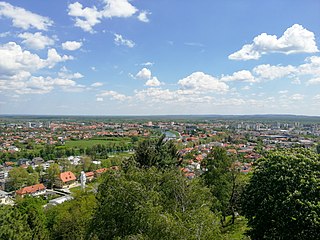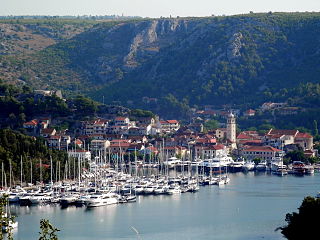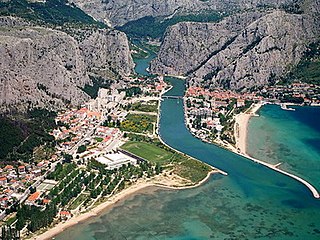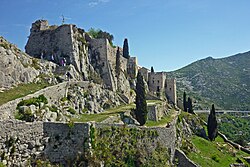
Karlovac is a city in central Croatia. In the 2021 census, its population was 49,377.

Senj is a town on the upper Adriatic coast in Croatia, in the foothills of the Mala Kapela and Velebit mountains.

Makarska is a town on the Adriatic coastline of Croatia, about 60 km (37 mi) southeast of Split and 140 km (87 mi) northwest of Dubrovnik, in the Split-Dalmatia County.

Skradin is a small town in the Šibenik-Knin County of Croatia. It is located near the Krka river and at the entrance to the Krka National Park, 17 km (11 mi) from Šibenik and 100 km (62 mi) from Split. The main attraction of the park, Slapovi Krke, is a series of waterfalls, the biggest of which, Skradinski buk, was named after Skradin.

Sinj is a town in the continental part of Split-Dalmatia County, Croatia.

Imotski is a small town on the northern side of the Biokovo massif in the Dalmatian Hinterland of southern Croatia, near the border with Bosnia and Herzegovina. Imotski, like the surrounding inland Dalmatia, has a generally mild Mediterranean climate which makes it a popular tourist destination.

The Uskoks were irregular soldiers in Habsburg Croatia that inhabited areas on the eastern Adriatic coast and surrounding territories during the Ottoman wars in Europe. Bands of Uskoks fought a guerrilla war against the Ottomans, and they formed small units and rowed swift boats. Since the uskoks were checked on land and were rarely paid their annual subsidy, they resorted to acts of piracy.

Drniš is a town in the Šibenik-Knin County, Croatia. Located in the Dalmatian Hinterland, it is about halfway between Šibenik and Knin.

Omiš is a town and port in the Dalmatia region of Croatia, and a municipality in the Split-Dalmatia County. The town is approximately 25 kilometres south-east of Croatia's second largest city, Split, where the Cetina River meets the Adriatic Sea. Omiš municipality has a population of 14,936 and its area is 266 square kilometres (103 sq mi).

Obrovac is a town located in northern Dalmatia, in the Zadar County of Croatia. The Obrovac municipality has a total population of 4,323 people. The town is located in the canyon of the river Zrmanja.

Karlobag is a seaside municipality on the Adriatic coast in Croatia, located underneath the Velebit mountains overlooking the island of Pag, west of Gospić and south of Senj. The Gacka river also runs through the area.

Trilj is a municipality and town in inland Dalmatia, Croatia. It is located northeast of Split.

Perušić is municipality (općina) in Lika-Senj County, Croatia. The municipality has 2,638 inhabitants, while the settlement itself has 852. The municipality is within the mountainous Lika region of central Croatia. The Kosinj valley region sprawls alongside it.
Kaštel Novi is a town within the administrative area of Kaštela in Dalmatia, Croatia. Its name means New Castle.

The Klis Fortress is a medieval fortress situated above a village bearing the same name, near Split, Croatia. From its origin as a small stronghold built by the ancient Illyrian tribe Dalmatae, becoming a royal castle that was the seat of many Croatian kings, to its final development as a large fortress during the Ottoman wars in Europe, Klis Fortress has guarded the frontier, being lost and re-conquered several times throughout its more-than-two-thousand-year-long history. Due to its location on a pass that separates the mountains Mosor and Kozjak, the fortress served as a major source of defense in Dalmatia, especially against the Ottoman advance, and has been a key crossroad between the Mediterranean belt and the Balkan rear.
Blinja is a village in central Croatia, in the Town of Petrinja, Sisak-Moslavina County. It is connected by the D30 highway.

Sumartin is a port village in Croatia on the island of Brač. It is the youngest village on the island of Brač and administratively belongs to Municipality of Selca. According to 2011 census, it has a population of 491. Village was founded on 11 November 1646 - the feast day of Saint Martin - by the refugees from the Dalmatian coast and Bosnia and Herzegovina who fled from the Ottomans. It is connected by the D113 highway and by ferry.

The siege of Klis or Battle of Klis was a siege of Klis Fortress in the Kingdom of Croatia within Habsburg monarchy. The siege of the fortress, which lasted for more than two decades, and the final battle near Klis in 1537, were fought as a part of the Ottoman–Habsburg wars between the defending Croatian–Habsburg forces under the leadership of Croatian feudal lord Petar Kružić, and the attacking Ottoman army under the leadership of the Ottoman general Murat-beg Tardić.
Islam Grčki is a village in the municipality of Benkovac, in the Zadar County, Croatia.

Šumber is a village and ruinous castle in the eastern part of Istria County, Croatia, in the municipality of Sveta Nedelja.























